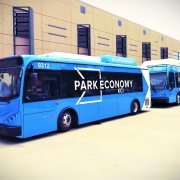MUD’s rolling around in the CNG
MUD’s rolling around in the CNG
By Jerry LaMartina
Metropolitan Energy Center
The Metropolitan Utilities District of Omaha is used to going it alone and forming partnerships when it comes to adopting and expanding its use of alternative fuels.
MUD first started using natural gas vehicles (NGVs) and compressed natural gas (CNG) fueling equipment in its operations in the early 1980s. NGVs include vehicles fueled by CNG and by liquefied natural gas.
At the end of 2013, MUD had more than 150 vehicles fueled by CNG, or roughly 40 percent of its 375-vehicle fleet.
One of its recent CNG expansions came in the form of 42 CNG vehicles and two CNG fueling stations, funded in part from $1.6 million awarded to it and several partners from a $15 million U.S. Department of Energy (DOE) Clean Cities grant awarded in December 2009. The overall grant also benefited several other municipalities and companies for alternative-fuel projects and was administered by Kansas City-based Metropolitan Energy Center (MEC) for the DOE. All the projects supported by the grant constitute MEC’s Midwest Region Alternative Fuels Project.
Mike Corrigan, MUD’s natural gas vehicle specialist, says the utility’s watchwords are environmental, economic and energy-independent. The economic leg of that stool showed itself in 2008 when fuel prices rose. This prompted MUD’s customers to ask the public utility about adding a public-access CNG station, Corrigan says.
“We’ve traditionally generated our revenue based on household and residential use, both of which have been declining, so we were looking toward other revenue sources,” he says. “Before 2008 or 2009, it wasn’t viable to move toward an increased percentage of CNG vehicles in our fleet, because of financial limitations and limited vehicle systems availability.”
Now, though, he thinks he’ll eventually see his whole fleet switch to CNG. MUD has added more than 40 CNG vehicles since this Clean Cities-funded project, all without grant funding.
Corrigan embraces CNG mainly because “it’s clean and it’s American.”
“At the end of the day, I’m glad to tell my kids that I’m doing something to reduce our emissions and reduce our dependence on foreign oil,” he says.
Those environmental and energy-independence concerns, along with economic ones, are common motivators for those who consider making the switch to alternative fuels.
“There’s a quandary of the chicken and the egg,” Corrigan says. “Do you build stations first or get CNG vehicles first?”
His advice is to first do market development by joining with facilitators and partners.
“You need to have a commitment from an anchor fleet before you start building a station,” he says.
Along with that, MUD spends a lot of time and energy reaching out to fleets, and teaching technicians and dealerships about what’s required to move to CNG.
MUD’s partners and their projects in this Clean Cities grant:
• Happy Cab Co. of Omaha bought 54 CNG taxi cabs and one CNG tow truck, and leased space to MUD for one of its public CNG stations.
• Metropolitan Community College of Omaha bought one CNG service van and one security pickup, and installed one private CNG fueling station.
• O’Daniel Honda of Omaha installed one CNG fueling station after having started selling and servicing CNG Honda models in 2009.
• Lincoln Airport Authority in Lincoln, Neb., bought six CNG pickups and one SUV, and installed one public CNG fueling station.
• Black Hills Energy of Lincoln joined as a project partner after supplement funding became available. It installed a public CNG station at its headquarters.
All of these partners have expanded their use of CNG vehicles beyond what was funded by this Clean Cities grant, Corrigan says, and they’ve done so with no federal funds, “which demonstrates that the market for CNG vehicles has become viable and sustainable.”
*************************
lamartina.jerry@gmail.com



